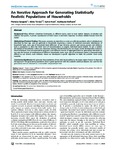Please use this identifier to cite or link to this item:
http://www.alice.cnptia.embrapa.br/alice/handle/doc/864056| Title: | An iterative approach for generating statistically realistic populations of households. |
| Authors: | GARGIULO, F.  TERNES, S.   HUET, S.   DEFFUANT, G.   |
| Affiliation: | FLORIANA GARGIULO, LISC/CEMAGREF; SONIA TERNES, CNPTIA, LISC/CEMAGREF; SYLVIE HUET, LISC/CEMAGREF; GUILLAUME DEFFUANT, LISC/CEMAGREF. |
| Date Issued: | 2010 |
| Citation: | PLoS ONE, San Francisco, v. 5, n. 1, 2010. |
| Pages: | p. 1-9. |
| Description: | Background. Many different simulation frameworks, in different topics, need to treat realistic datasets to initialize and calibrate the system. A precise reproduction of initial states is extremely important to obtain reliable forecast from the model. Methodology/Principal Findings. This paper proposes an algorithm to create an artificial population where individuals are described by their age, and are gathered in households respecting a variety of statistical constraints (distribution of household types, sizes, age of household head, difference of age between partners and among parents and children). Such a population is often the initial state of microsimulation or (agent) individual-based models. To get a realistic distribution of households is often very important, because this distribution has an impact on the demographic evolution. Usual techniques from microsimulation approach cross different sources of aggregated data for generating individuals. In our case the number of combinations of different households (types, sizes, age of participants) makes it computationally difficult to use directly such methods. Hence we developed a specific algorithm to make the problem more easily tractable. Conclusions/Significance. We generate the populations of two pilot municipalities in Auvergne region (France) to illustrate the approach. The generated populations show a good agreement with the available statistical datasets (not used for the generation) and are obtained in a reasonable computational time. |
| Thesagro: | Simulação |
| Keywords: | Algoritmo População x tarefas do lar Projeto PRIMA Algorithm Artificial population Population distributed in households Prototypical Policy Impacts on Multifunctional Activities - PRIMA Simulation Synthetic population |
| DOI: | 10.1371/journal.pone.0008828.t002 |
| Type of Material: | Artigo de periódico |
| Access: | openAccess |
| Appears in Collections: | Artigo em periódico indexado (CNPTIA)  |
Files in This Item:
| File | Description | Size | Format | |
|---|---|---|---|---|
| journal.pone.0008828.pdf | 1,25 MB | Adobe PDF |  View/Open |









